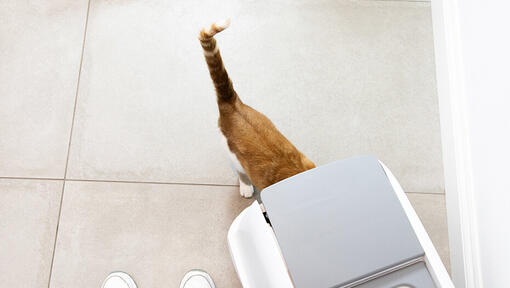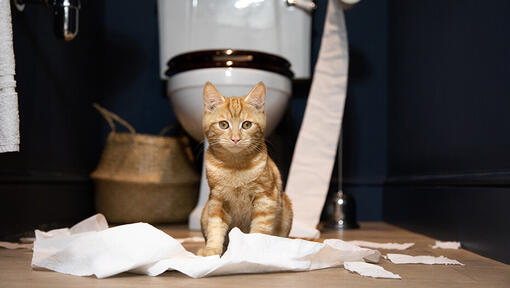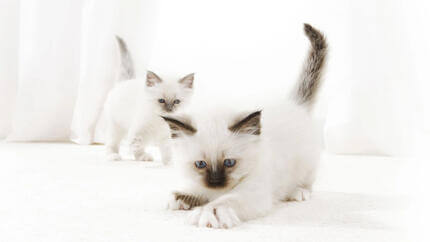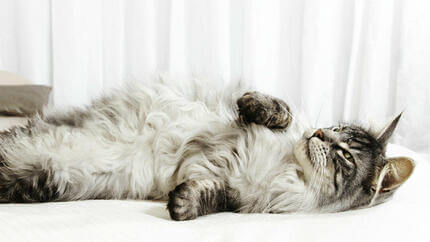Tout savoir sur la façon d'apprendre à votre chaton à utiliser sa litière
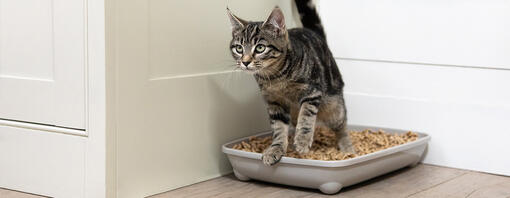
Dès que votre chaton arrive à la maison, placez-le dans son bac à litière afin qu'il s'habitue à son odeur et à son contact. Placez-le dans le bac à litière dès que vous pensez que c'est nécessaire : après les repas et lorsqu'il se réveille.
S'il s'accroupit dans la maison, prenez-le doucement et placez-le immédiatement dans son bac à litière.
Vous n'aurez rien d'autre à faire pour apprendre la propreté à la plupart des chatons. Continuez simplement à le placer dans son bac jusqu'à ce qu'il comprenne.
Choisir un bac à litière
- Un bac pour chat ou pour chaton ?
Il existe des petits bacs à litière pour chaton mais celui-ci risque de grandir rapidement et vous devrez lui imposer une nouvelle phase d'apprentissage lorsque vous passerez un bac plus grand. Choisissez un bac pour adulte dès le début.
Votre chaton n'aura aucun problème pour monter dans un grand bac à litière. S'il montre des difficultés pour grimper, créez-lui une petite rampe en bois ou avec une autre surface plane et non glissante. Collez la rampe sur le côté du bac avec du ruban adhésif et enlevez-la dès que votre chaton est assez grand pour monter dedans tout seul.
- Fermé ou ouvert ?
Un bac à litière fermé est comme une salle de bain privée pour votre chaton. Certains chats se sentent protégés dans un bac fermé. De plus, cela permet de garder la litière à l'intérieur du bac et de limiter les odeurs. Cependant, certains chats peuvent se sentir trop coincés dans un bac fermé. Vous pouvez l'aider à s'adapter en enlevant la petite porte jusqu'à ce qu'il s'habitue au bac fermé.
Choisir une litière
Achetez une litière sans odeur ou avec un parfum discret car les parfums forts peuvent irriter le nez et les yeux de votre chat.
La litière doit dégager aussi peu de poussière que possible car elle risque d'endommager les poumons délicats de votre chat.
Lorsque vous avez choisi une marque, essayez de ne pas en changer car cela pourrait perturber votre chaton.
Choisir un endroit adapté pour la litière
Placez le bac dans un endroit calme pour éviter que des bruits soudains n'effraient votre chaton.
This type of litter is convenient as it will clump into balls when it comes into contact with liquids, this makes it easy to scoop and can help to save money as it ensures you’re only scooping out dirty litter.
You should consider using a dust free litter if your cat has an enclosed litter tray as dust won’t be thrown into your cat’s face when they’re busy burying their business.
These litter types are great as they absorb liquids extremely fast and they’re generally quite cheap – they won’t eliminate smells though.
This is a popular option as it absorbs well and can help with odour control somewhat, however it is more expensive than other options.
These are good if you’re looking to absorb liquids and odours fast, but this type is one of the most expensive cat litter options.
It’s usually better to avoid this type as they can upset your cat’s sensitive nose and put them off using the tray altogether.
If you need to change the type of litter you use, do it slowly so that it doesn’t come as a surprise to your cat and put them off. Follow the instructions on the litter packaging for recommended depth of litter, making sure that your cat has enough to dig with. If you want to catch any loose debris, place some newspaper beneath the tray.
Where to put the litter tray
The general rule is that there should be one litter tray per cat, plus an extra one in your home. Put each tray in a quiet area where they can go to the toilet in peace, avoiding busy hallways or near noise sources such as a washing machine. You should also choose a spot away from where they eat and drink.
When you’re litter training a kitten, always make sure that the tray can be easily accessed, especially if your cat spends all of their time in the house. As cats are very clean animals, they will hold on as long as possible if there’s nowhere for them to go, which can be very uncomfortable and lead to health problems.
3 steps to litter training kittens and cats
If you’ve recently got a new kitten or are trying to teach an older cat how to use the tray, follow these 3 simple steps for litter training:
1. Know the signs when they’re ready to go
The first thing you’ll need to do when cat toilet training is to keep an eye on them and watch for the signs of when they need to go. You’ll probably see them sniffing, scratching or crouching on the floor.
2. Put them on the litter tray
When you spot the signs, simply lift them up and gently place them in the tray. As kittens have very small bladders, you should also put them on their tray straight away after eating and as soon as they wake up. Soon your kitten will start to associate going to the toilet with being in the tray, and will make their own way there.
3. Praise their success
After they’ve successfully used the tray, give them lots of praise and a tasty cat treat too. They’ll soon learn to think of the litter tray in a positive manner and will be using it confidently in no time.
Tant que votre chat est petit, le bac à litière doit être placé dans un endroit où il passe beaucoup de temps. Il est mieux qu'il puisse voir le bac à litière afin de l'encourager à l'utiliser lorsqu'il en ressent le besoin.
Si vous décidez de changer le bac de place, faites-le progressivement en le déplaçant de quelques centimètres de temps en temps. Sinon, vous pourriez perturber votre chaton et des accidents pourraient se produire. L'astuce est de placer la gamelle de votre chaton à l'endroit où se trouvait le bac à litière car la plupart des chats ne font pas leurs besoins là où ils mangent.
Nettoyer la litière
Les chatons n'aiment pas les bacs à litière sales. Si vous ne changez pas la litière, votre chaton trouvera un endroit plus propre, votre tapis par exemple !
Pour nettoyer le bac à litière, retirez les excréments du bac et jetez-les. Environ une fois par semaine, jetez toute la litière et nettoyez le bac avec de l'eau chaude et du savon. Rincez et séchez le bac puis remplissez-le avec de la litière propre.
Vous êtes maintenant prêt à profiter de votre chaton parfaitement dressé !


